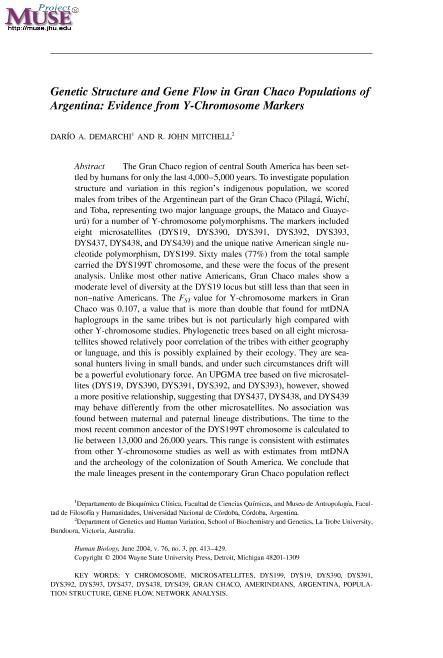Artículo
Genetic structure and gene flow in Gran Chaco populations of Argentina: Evidence from Y-chromosome markers
Fecha de publicación:
12/2004
Editorial:
Wayne State University Press
Revista:
Human Biology
ISSN:
0018-7143
Idioma:
Inglés
Tipo de recurso:
Artículo publicado
Clasificación temática:
Resumen
The Gran Chaco region of central South America has been settled by humans for only the last 4,000-5,000 years. To investigate population structure and variation in this region's indigenous population, we scored males from tribes of the Argentinean part of the Gran Chaco (Pilagá, Wichí, and Toba, representing two major language groups, the Mataco and Guaycurú) for a number of Y-chromosome polymorphisms. The markers included eight microsatellites (DYS19, DYS390, DYS391, DYS392, DYS393, DYS437, DYS438, and DYS439) and the unique native American single nucleotide polymorphism, DYS199. Sixty males (77%) from the total sample carried the DYS199T chromosome, and these were the focus of the present analysis. Unlike most other native Americans, Gran Chaco males show a moderate level of diversity at the DYS19 locus but still less than that seen in non-native Americans. The FST value for Y-chromosome markers in Gran Chaco was 0.107, a value that is more than double that found for mtDNA haplogroups in the same tribes but is not particularly high compared with other Y-chromosome studies. Phylogenetic trees based on all eight microsatellites showed relatively poor correlation of the tribes with either geography or language, and this is possibly explained by their ecology. They are seasonal hunters living in small bands, and under such circumstances drift will be a powerful evolutionary force. An UPGMA tree based on five microsatellites (DYS19, DYS390, DYS391, DYS392, and DYS393), however, showed a more positive relationship, suggesting that DYS437, DYS438, and DYS439 may behave differently from the other microsatellites. No association was found between maternal and paternal lineage distributions. The time to the most recent common ancestor of the DYS 199T chromosome is calculated to lie between 13,000 and 26,000 years. This range is consistent with estimates from other Y-chromosome studies as well as with estimates from mtDNA and the archeology of the colonization of South America. We conclude that the male lineages present in the contemporary Gran Chaco population reflect the level of diversity found in South America and that the region's male founders did not carry a restricted gene pool.
Archivos asociados
Licencia
Identificadores
Colecciones
Articulos(IDACOR)
Articulos de INSTITUTO DE ANTROPOLOGIA DE CORDOBA
Articulos de INSTITUTO DE ANTROPOLOGIA DE CORDOBA
Citación
Demarchi, Dario; Mitchell, R. John; Genetic structure and gene flow in Gran Chaco populations of Argentina: Evidence from Y-chromosome markers; Wayne State University Press; Human Biology; 76; 3; 12-2004; 413-439
Compartir
Altmétricas




